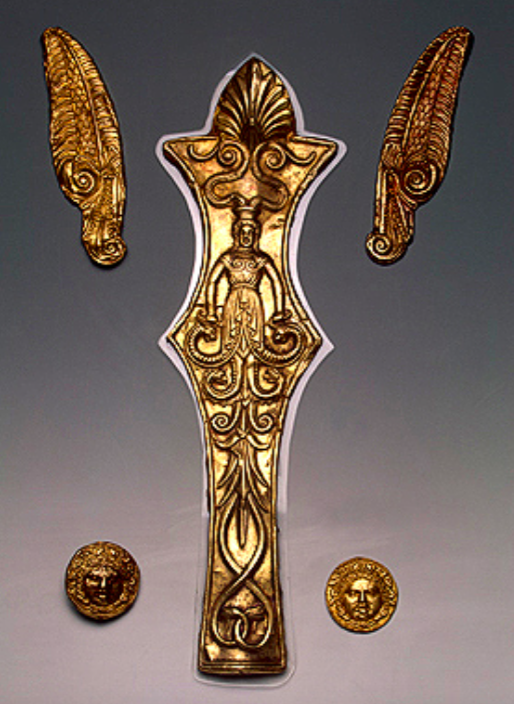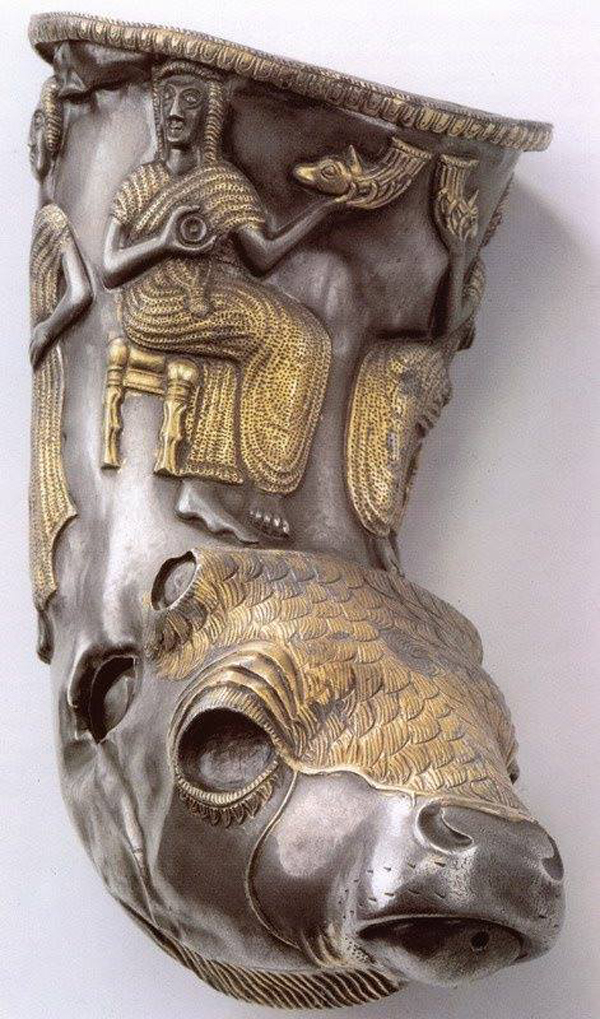非常にインパクトのある黄金の冠です。ブルガリアの古墳出土の宝物も豪華ですね。地図に英語が書かれているので、元記事は英語の記事のようです。MIHO美術館で見たリュトンが載っていて興味深いです。

スヴェシュタリにあるトラキア王族の古墳
Thracian royal mound in Sveshtari
ブルガリアの歴史的および考古学的保護区「Sboryanovo」は、マラック、ポロヴェッツ、スヴェシュタリの村の間、クラペニツァ川の峡谷とその周辺の丘の上にあります。 スヴェシュタリ王家の墓は、半径2 km以内にある巨大な古墳で、その隣にさらに26もの古墳が見つかりました。
Bulgarian historical and archaeological reserve "Sboryanovo", located between the villages of Malak, Porovets, Sveshtari, in the canyon of the Krapenitsa River and on the hills around. The royal tomb in Sveshtari is a giant mound, within a radius of two kilometers, next to which 26 more mounds were found.
スヴェシュタリの町での考古学的発掘は1982年以来行われており、この間に古代トラキア人の約150の埋葬墳丘、好戦的なゲタエがすでに調査されています。トラキアの古墳の中で最大のもので、数多く黄金の宝石が発見され、現在はユネスコによって世界遺産として保護されています。
Archaeological excavations in the town of Sveshtari have been conducted since 1982, during which time about 150 burial mounds-tombs of the ancient Thracians, warlike Getae have already been investigated. In the largest of the ancient tombs of Thrace, numerous gold jewelry were discovered, which are now protected by UNESCO as a World Heritage Site.
 30年前にスヴェシュタリで発見されたゲタエのトラキア王とその妻の王家の墓は、紀元前3世紀にまでさかのぼります。考古学者によるこの発見は、考古学世界でセンセーションを巻き起こしました。真の歴史的価値は、モルタルなしで石灰岩のスラブから配置され、互いにしっかりと取り付けられている霊廟の内部だけでなく、無数の黄金の宝物にあります。
30年前にスヴェシュタリで発見されたゲタエのトラキア王とその妻の王家の墓は、紀元前3世紀にまでさかのぼります。考古学者によるこの発見は、考古学世界でセンセーションを巻き起こしました。真の歴史的価値は、モルタルなしで石灰岩のスラブから配置され、互いにしっかりと取り付けられている霊廟の内部だけでなく、無数の黄金の宝物にあります。
The royal tomb of the Thracian king of the Getae and his wife, discovered 30 years ago in Sveshtari, dates back to the 3rd century BC. This discovery by archaeologists was a real sensation in the world of archeology. Real historical value is not only the interior of the mausoleum, laid out of limestone slabs, without mortar, tightly fitted to each other, but also countless gold treasures.

黒海とアゾフ地域は、インド・ヨーロッパの言語と文化の発祥地であると考えられています。青銅時代にこの領土で形成された民族グループは、バルカン半島とコーカサスに移住しました。これらの2つの方法で、小アジアと中央アジア、および東ヨーロッパ、中央ヨーロッパ、南東ヨーロッパの多くの地域に定住しました。
The Black Sea and Azov regions are considered to be the cradle of the Indo-European language and culture. Ethnic groups that formed on this territory in the Bronze Age migrated to the Balkan Peninsula and the Caucasus - in these two ways they settled in Asia Minor and Central Asia, and a number of regions of Eastern, Central and South-Eastern Europe.
スヴェシュタリにあるトラキア王家の墓は、伝統的なシチリアの古墳で、構造はシチリアの埋葬と完全に似ており、同じ通路の廊下(ドロモス)と3つの正方形の部屋(正面、側面、主な埋葬室)の中にあり、半円筒形の丸天井で覆われています。
The Thracian royal tomb of Sveshtari is a traditional Scythian burial mound, in structure absolutely similar to the Scythian burials, inside the same passage-corridor (dromos) and three square chambers: the front, side and main burial chamber, covered with a semi-cylindrical vault.

ヘレニズム建築で彫刻的な装飾と浮き彫りで豊かに装飾された王家の霊廟は、その豊かさと色の輝きが印象的です。墓の入り口には、様式化された雄牛の頭、ロゼット、葉と花の花輪が付いたアーチ型の縁飾りで装飾された2つの長方形の柱があります。
The royal mausoleum, richly decorated with sculptural decorations and bas-reliefs in the spirit of Hellenistic architecture, is striking in its richness and brightness of color. At the entrance to the tomb there are two rectangular columns decorated with an architrave with a frieze of stylized bull's heads, rosettes and garlands of leaves and flowers.
高さ1.20メートル、両手を高く上げた10人の美しい女性像の浮き彫りは、素晴らしい印象を与えます。それらは、パンティカペウム(ケルヒ)近くのクル・オバ古墳で見つかったスキタイ蛇紋の女神のイメージに似ています。
The bas-relief of ten beautiful female figures, 1.20 meters high, with their hands raised high, makes a great impression. They resemble the image of the Scythian serpentine goddess found in the Scythian mound Kul-Oba, near Panticapaeum (Kerch).

蛇紋の女神、ボリスフェナ川(ドニエパー)の娘、シチリア人の祖先と見なされている神話上のシチリア王タルギタイの母の絵にも同様の特徴が見られます。へびのような曲がりくねった女神はいつも腕を上げて描かれ、野生動物を抱いていました。
ボリスフェナ川の波に似た、ドレスの上向きに湾曲した縁の形をした蛇の様式化された画像。 スキタイ蛇紋の女神の像は、スヴェシュタリのトラキアの古墳での埋葬より100年早くパンティカパエウムで創造されました。
We see similar features in the image of the Serpentine Goddess, daughter of the Borisfen River (Dnieper), mother of the mythical Scythian king Targitai (targ - bull, tai - king), who is considered the ancestor of the Scythians. The serpentine goddess was always depicted with raised arms, in which she held wild animals.
Stylized image of snakes in the form of upward curved edges of a dress, similar to the waves of the Borisfena River. The image of the Scythian serpentine goddess was created in Panticapaeum 100 years earlier than the burial in the Thracian mound of Sveshtari.
*ここで比較のため紀元前4世紀のボルシャヤ・ツィンバルカ古墳出土の、スキタイの蛇状の女神が彫刻されている馬のハーネスの写真がありますので置いておきます。蛇の顔が6匹表現されています。蛇の顔を省略したのが、トラキア王家の上に載せた写真ですよね。羽2枚は耳のあたりにつけたのでしょうか。

ここから記事に戻ります。

銀色のボウルは、その下に様式化された角を持つ女神を描いています-神聖な雄牛の頭 スヴェシュタリ古墳の10人の女性は、みな長いギリシャの衣装に身を包み、胸の下に細い紐を結んでいます。スキタイの蛇紋の女神の儀式的な描写のように、彼女たちの衣装の端は跳ね上がっています。
The silver bowl depicts goddesses with stylized horns, under them - the heads of sacred bulls All ten women in the Sveshtari mound are dressed in long Greek tunics, tied with a thin strap under their breasts. The edges of their tunics are raised, as in the ritual depiction of the clothing of the Scythian serpentine goddess.

スヴェシュタリ墳丘のトラキア王家の墓で、王の黄金の埋葬マスク(重量690グラム)が見つかりました。ポントゥス・ユーシーヌ(黒海)の海岸に住むトラキア人は、黒海のシチリア人のように、自分たちを欠けていると自称し、金髪碧眼で、口髭がありました。トラキアの王は絶対にスラブ人の外見です。
In the royal Thracian tomb in the Sveshtari mound, a unique golden burial mask (weight 690 grams) of the king was found. The Thracians living on the shores of the Pontus Euxine (Black Sea), like the Black Sea Scythians-plowmen, who call themselves chipped, were fair-haired and blue-eyed, wore mustaches and beards - absolutely Slavic appearance of the Thracian king.

ギリシャの哲学者ゼノファネスは、トラキア人について説明し、外見上はトラキア人はギリシャ人とは異なっていたと報告しています。トラキア人はブロンドの髪と青い目を持っていました、それはトラキア人と彼らの神々が表した方法です。 「すべてのエチオピア人は、神々を黒くて鼻をつまんでいると考えています。 トラキア人は彼らを青い目と金髪だと思っています...」
Describing the Thracians, the Greek philosopher Xenophanes reports that outwardly the Thracians were different from the Greeks. The Thracians had blonde hair and blue eyes, that is how the Thracians and their gods represented. "All the Ethiopians think of the gods as black and snub-nosed, The Thracians think of them as blue-eyed and fair-haired ... "


自分たちを「縁が欠けた」と自称する黒海のスキタイ・パハリのようなトラキア人は、故人の服を王室の墳丘に多数の黄金の縞模様、黄金の装飾品、黄金のマスクで飾るという伝統で知られていました。シチリアとトラキアの王室の古墳の周りで、葬式の大きな饗宴をした痕跡が見つかりました。
The Thracians, like the Black Sea Scythians-Pahari, who call themselves chipped, were known for their tradition of decorating the clothes of the deceased with many gold stripes, gold jewelry and golden masks in the royal barrows. Around the Scythian and Thracian royal kurgans, traces of a funeral feast, a great feast were found.

多くの黄金と銀の皿が、スヴェシュタリの古墳で見つかりました。ギリシャの赤い花瓶と銀のゴブレット、彫刻と黄金の飾り板で飾られたワイン入れ。ヘレニズム化されたトラキア社会と宮廷の中で、キリカ、カンファーなどのワインの器は、高貴なトラキア人とスキタイ人の饗宴に不可欠なものでした。
Many gold and silver dishes were found in the burial mounds of Sveshtari - Greek red-figure vases and silver goblets, wine bowls decorated with engraving and gold plates. Vessels for wine - phials, kilikas, kanfars in the Hellenized Thracian society and at the royal court were indispensable attributes of the feast of the noble Thracians and Scythians.

壮大な銀と黄金のリュトンに特別な注意を払う必要があります。下に注ぎ口がある、ギリシャ神話のゼウスに授乳したヤギの角の形をした、円錐形のワインを注ぐ特別な容器です。
Special attention should be paid to the magnificent silver and gold rhytons - special vessels for drinking wine in the shape of a "cornucopia" with a sculptural end (protome) below.

古代世界の歴史の中で、トラキア人は勇敢で巧みな戦士として彼ら自身を称賛しました。王家の古墳では、持ち手が黄金でトリミングされた独特な青銅の剣が見つかりました。王の青銅の鎧、前面と背面の飾り板が一緒に結ばれていました。
The Thracians in the history of the Ancient World glorified themselves as brave and skillful warriors. In the royal burial mound, a unique bronze royal sword with a handle trimmed with gold was found, the bronze armor of the king - the front and back plates were tied together.

シチリアの「動物スタイル」で装飾された剣、矢と槍の頭、馬のハーネスの装飾品が武器から発見されました。
A sword decorated in the Scythian "animal style", arrows and spearheads, ornaments of a horse harness were found from weapons.
 ブルガリアの土地が保持していた無数の宝物は、考古学者の努力によって日の目を見ました。彼らはトラキアの地に住む人々の秘密のベールを持ち上げ、彼らの壮大な創造物の中にある古代の芸術家の技術と感性を示しました。
ブルガリアの土地が保持していた無数の宝物は、考古学者の努力によって日の目を見ました。彼らはトラキアの地に住む人々の秘密のベールを持ち上げ、彼らの壮大な創造物の中にある古代の芸術家の技術と感性を示しました。
The countless treasures that the land of Bulgaria kept in itself were born through the efforts of archaeologists. They managed to lift the veil of secrets of the peoples inhabiting the land of Thrace and demonstrate the skill and perception of the ancient artists in their magnificent creations.

*参考までに、クリミアのクル・オバ古墳からは以下のティアラとアテネの顔ペンダントが出土していますが、ティアラに上記の筆記体小文字のエックスのような女神がついているように思います。
